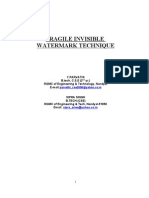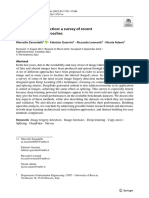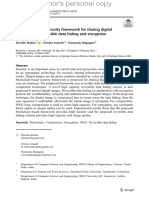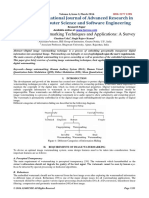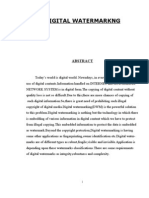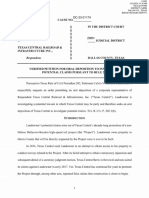8 Vol2
8 Vol2
Copyright:
Available Formats
8 Vol2
8 Vol2
Original Title
Copyright
Available Formats
Share this document
Did you find this document useful?
Is this content inappropriate?
Copyright:
Available Formats
8 Vol2
8 Vol2
Copyright:
Available Formats
68
Megha Jyoti, Varinder Singh
Comparison between Naive Encryption & Pixel correlation method for optimizing the performance of Image Encryption by digital Watermarking
Megha Jyoti1,Varinder Singh2
1
jyoti5337@gmail.com, 2singhgamer@gmail.com
ABSTRACT :The recent advent in the field of multimedia proposed a many facilities in transport, transmission and manipulation of data. Along with this advancement of facilities there are larger threats in authentication of data, its licensed use and protection against illegal use of data. Digital watermarking is one of the most recent proposed systems to observe the authentication of licensed user over e-commerce applications and finds its uses in illegal applications like copying the multimedia data e.g. images, audio, video. The watermark indicates that data is containing copyright or not. To propose a measure against the illegal use of the images different available watermarking standards are studied. Then by taking the human visual system into consideration an algorithm is designed and it is implemented with use of C#. The algorithm designed is based on available watermarking methods but different in sense that it tends to prevent the illegal use of multimedia image. If any effort is done to copy or download the image in any unauthentic way i.e. without availability of any license or the Private Key issued by the owner the designed software damages the content of that image file so that the image looses its commercial value. This paper conducts a literature survey of watermarks used for images on Remote Web Server. It describes the previous work done on digital watermarks, including the analysis of various watermarking schemes and their results. Potential applications are discussed, and an implementation plan of the project is presented. Key Words: Digital Watermarking, Copyright Protection, authentication, RGB.
2011 Anu Books
Research Cell: An International Journal of Engineering Sciences ISSN: 2229-6913 Issue July 2011, Vol. 1
69
1.
INTRODUCTION
Digital watermarking includes a number of techniques that are used to imperceptibly convey information by embedding it into the cover data [6]. There has always been a problem in establishing the identity of the owner of an object. In case of a dispute, identity was established by either printing the name or logo on the objects. But in the modern era where things have been patented or the rights are reserved (copyrighted), more modern techniques to establish the identity and leave it in tampered have come into Picture. Unlike printed watermarks, digital watermarking is a technique where bits of information are embedded in such a way that they are completely invisible. The problem with the traditional way of printing logos or names is that they may be easily tampered or duplicated. In digital watermarking, the actual bits are scattered in the image in such a way that they cannot be identified and show resilience against attempts to remove the hidden data [7]. Watermarking, as opposed to steganography, has an additional requirement of robustness against possible attacks. An ideal steganographic system would embed a large amount of information perfectly securely, with no visible degradation to the cover object. An ideal watermarking system, however, would embed an amount of information that could not be removed or altered without making the cover object entirely unusable. Over the past few years, there has been tremendous growth in computer networks and more specifically, the World Wide Web. This phenomenon, coupled with the exponential increase of computer performance, has facilitated the distribution of multimedia data such as images. Publishers, artists, and photographers, however, may be unwilling to distribute pictures over the Internet due to a lack of security; images can be easily duplicated and distributed without the owners consent. Digital watermarks have been proposed as a way to tackle this tough issue. This digital signature could discourage copyright violation, and may help determine the authenticity and ownership of an image. This paper is a literature survey of digital watermarks. Its objective is to summarize the previous work done on digital watermarks and to detail the implementation plan of the project. The paper is organized as follows: Section 2 gives a general description of a digital watermark. Section 3 describes selective encryption for uncompressed images Section 4 explains the potential applications of watermarking, and section 5 presents the implementation plans for the project. Finally, section 6 gives a conclusion of the work done. 2. THE DIGITALWATERMARK-A BRIEF DESCRIPTION
As a side effect of these different requirements, a watermarking system will often trade Capacity and perhaps even some security for additional robustness [9].The working principle of the watermarking techniques is similar to the steganography methods. A watermarking system is made up of a watermark embedding system and a watermark recovery system. The system also has a key which could be either a public or a secret
2011 Anu Books
70
Megha Jyoti, Varinder Singh
key. The key is used to enforce security, which is prevention of unauthorized parties from manipulating or recovering the watermark. The embedding and recovery processes of watermarking are shown in Figures
Fig 2.1 : General Watermarking Block Diagram
Fig 2.2 : General Watermarking Decoding to recover Original Image
For the embedding process the inputs are the watermark, cover object and the secret or the public key. The watermark used can be text, numbers or an image. The resulting final data received is the watermarked data W. The inputs during the decoding process are the watermark or the original data, the watermarked data and the secret or the public key. The output is the recovered watermark W. In general, watermark is a code that is embedded inside an image. It acts as a digital signature, giving the image a sense of ownership or authenticity. Ideal properties of a digital watermark have been stated in many articles and papers [1-3]. These properties include: 1) A digital watermark should be perceptually invisible to prevent obstruction of the original image. 2) A digital watermark should be statistically invisible so it cannot be detected or erased. 3) Watermark extraction should be fairly simple. Otherwise, the detection process requires too much time or computation.
2011 Anu Books
Research Cell: An International Journal of Engineering Sciences ISSN: 2229-6913 Issue July 2011, Vol. 1
71
4)
Watermark detection should be accurate. False positives, the detection of a no marked image, and false negatives, the non-detection of a marked image, should be few. Numerous watermarks can be produced. Otherwise, only a limited number of images may be marked. Watermarks should be robust to filtering, additive noise, compression, and other forms of image manipulation.
5) 6)
3.
SELECTIVE ENCRYPTION OF UNCOMPRESSED IMAGES A very effective method to encrypt an image, which applies to a binary image, consists in mixing image data and a message (the key in some sense) that has the same size as the image: a XOR function is sufficient when the message is only used once. A generalization to gray level images is straightforward: encrypt each bitplane separately and reconstruct a gray level image. With this approach no distinction between bitplanes is introduced although the subjective relevance of each bitplane is not equal. [12] 3.1 Description of a naive method Figureshowsanimagedecomposedinitsbitplanes.
Figure: 2.1 LENA and her biplanes ( i7,...,i0) starting from the most significant bit.
2011 Anu Books
72
Megha Jyoti, Varinder Singh
The highest biplanes exhibit some similarities with the gray level image, but the least significant biplanes look random. Because encrypted bits also look random, the encryption of least significant biplanes will add noise to the image [10]. The first naive method we have implemented consists in the encryption of the least significant bits as illustrated in Table. In the same table, we provide two distortion measures as well: the Mean Square Error (MSE) and the Peak Signal to Noise Ratio (PSNR). An advantage of the technique that encrypts the least significant bits is that plaintext attacks are harder on random like data [10]. It should be noted that the security is linked to the ability to guess the values of the encrypted data. For example, from a security point of view, it is preferable to encrypt the bits that look the most random. However in practice, the tradeoff is more difficult because the most relevant information, like DC coefficients in a JPEG encoded image, usually are highly predictable [8]. As can be seen from the images drawn in Table 1, we need to encrypt at least 4 to 5 bitplanes before the degradation is visible. In theory the naive method is relatively robust to plaintext attacks because it encrypts bitplanes that contain nearly uncorrelated bit values. Next is the table that illustrates a naive selective encryption method [8]. Figure 2.2: Illustration of a naive selective encryption method.
(a) Original image
2011 Anu Books
Research Cell: An International Journal of Engineering Sciences ISSN: 2229-6913 Issue July 2011, Vol. 1
73
(b) bits encrypted MSE= 10.6, PSNR = 37.9 [dB]
(c) 5 bits encrypted MSE = 171, PSNR= 25.8[dB]
2011 Anu Books
74
Megha Jyoti, Varinder Singh
(d) 7 bits encrypted MSE = 2704, PSNR=13.8 [dB] 4. DIGITAL WATERMARKING IMPLEMENTED USING JAVA
Since a watermark is merely a sequence of pseudo-random numbers, error free detection may be possible by using linear block codes. With the exception of [11] most watermarking schemes do not employ error-correction. This research work will attempt to implement a new watermarking method using error-correction techniques. Tests will be performed to see if the watermark satisfies the desired properties mentioned in section 2. Furthermore, this research work will determine if the error-correcting watermark scheme will hold any advantages over traditional watermarking methods. 5. METHODOLOGY
In Our Technique We are representing each pixel as a matrix Say name is color matrix A color matrix is a matrix that contains values for channels. Its a 5x5 matrix which represents values for the Red, Green, Blue, Alpha channels and another element w, in that order (R, G, B, A, w). In a Color Matrix object, the diagonal elements of the matrix define the channel values viz. (0, 0), (1, 1), (2, 2), (3, 3), and (4, 4), in the order as specified before (R G B A w). The values are of type float,
2011 Anu Books
Research Cell: An International Journal of Engineering Sciences ISSN: 2229-6913 Issue July 2011, Vol. 1
75
and range from 0 to 1. The element w (at (4, 4)) is always 1.What you have to do is to create a new Color Matrix instance with the desired channel values. As we want to control the alpha blend channel, we should set the element at (3, 3) to the desired value as shown below: ColorMatrix ClrMatrix = { 1.0f, 0.0f, 0.0f, 0.0f, 0.0f, 0.0f, 1.0f, 0.0f, 0.0f, 0.0f, 0.0f, 0.0f, 1.0f, 0.0f, 0.0f, 0.0f, 0.0f, 0.0f, 1.0f, 0.0f, 0.0f, 0.0f, 0.0f, 0.0f, 1.0f, }; The 0.5f value in the above code represents the alpha blend value. 0.5 means semi transparent (50%). 5.1 Quality Metrics Signal-to-noise (SNR) measures are estimates of the quality of a reconstructed image compared with an original image. The basic idea is to compute a single number that reflects the quality of the reconstructed image. Reconstructed images with higher metrics are judged better. In fact, traditional SNR measures do not equate with human subjective perception. Several research groups are working on perceptual measures, but for now we will use the signal-to-noise measures because they are easier to compute. Just remember that higher measures do not always mean better quality. The actual metric we will compute is the peak signal-to-reconstructed image measure which is called PSNR. Assume we are given a source image f(i,j) that contains N by N pixels and a reconstructed image F(i,j) where F is reconstructed by decoding the encoded version of f(i,j). Error metrics are computed on the luminance signal only so the pixel values f (i,j) range between black (0) and white (255).First you compute the mean squared error (MSE) of the reconstructed image as follows
f (i , j ) F (i , j ) MSE
N2
2011 Anu Books
76
Megha Jyoti, Varinder Singh
The summation is over all pixels. The root mean squared error (RMSE) is the square root of MSE. Some formulations use N rather N^2 in the denominator for MSE. PSNR in decibels (dB) is computed by using PSNR=20Log10 (255 / RMSE) Typical PSNR values range between 20 and 40. They are usually reported to two decimal points (e.g., 25.47). The actual value is not meaningful, but the comparison between two values for different reconstructed images gives one measure of quality. 6. RESULTS & ANALYSIS
6.1 Selective Encryption Method vs. Pixel Correlation Method The Image Encryption is firstly applied to grey scale images for that case I have taken Lenas image as a test image. Different results have been observed with varying the Alpha by computing the performance measure like MSE, RMSE, and PSNR for an Encrypted/Watermarked Image. The results are then compared with Selective Encryption Method as shown in the table below.
Figure 6.1 Original Lena
2011 Anu Books
Research Cell: An International Journal of Engineering Sciences ISSN: 2229-6913 Issue July 2011, Vol. 1
77
Figure 6.2 Selected Watermarks Table 6.1 Image Encryption Results by using Naive Method
Table 6.2 Image Encryption Results by Pixel Correlation Method
2011 Anu Books
78
Megha Jyoti, Varinder Singh
Figure 6.3 Comparison between NM and ACM for Grey scale images For a single Image we have generated the four graphs as shown. The graph between Alpha & MSE shows that as we increase the value of Alpha Mean Square Error is decreased. We consider Mean square error as a noise in the image, if noise is reduced, then the Quality of watermarked image is improved. The Graph between Alpha & PSNR shows that by increasing the value of alpha PSNR value of an image also increases. If PSNR value is improved then we surely confirmed that image after encryption i.e. watermarked image is of good quality. For example take the encrypted SUNSET image we have Alpha=0.1, MSE=10.04 & PSNR=38.15. Now take another encrypted SUNSET image, we have Alpha=0.2, MSE=6.234 & PSNR=40.19. Hence forth by increasing the value of Alpha, MSE is decreased & PSNR is increased. i.e. Quality of Encrypted image is improved. We have also computed MSE & PSNR with varying Alpha to RGB Components of an image & same results stands true for RGB Component wise analysis. 7. CONCLUSION & FUTURE WORK
This paper represents technique of watermarking making use of human visibility system at different frequencies and gazing effects on different parts of the picture. The watermark generated is semi transparent type i.e. semi visible carrying the advantages of both the visible and the invisible watermark. More over the visibility of watermark is under control of an algorithm and can be very easily changes as per changing requirements. It carries the advantage of the visible watermark i.e. it is
2011 Anu Books
Research Cell: An International Journal of Engineering Sciences ISSN: 2229-6913 Issue July 2011, Vol. 1
79
robust and easily visible hence easy to detect the copyright on to the picture. It carries the advantages of non visible watermark also i.e. it does not interfere with the picture elements. It is manually designed by taking care of the picture statistic i.e. value of RGB and W components and more over it is placed on part of the picture which is not so significant portion. The proposed technique is compatible and can be programmed with latest user friendly languages which are in connection with the latest online, E-Commerce and shopping applications as given in the example. More over the proposed method can be applied to all types of image formats e.g. jpeg, bmp etc. Recent work has shown that digital watermarks can be fairly successful in achieving the desired properties mentioned in section 2. These watermarks, however, are not perfect, and more could be done to improve a watermarks robustness or accuracy in detection. Furthermore we can rotate the value of alpha channel to get the desired rate of water mark. The proposed technique has been applied and implemented in example on a digital image however the work can be extended to the video formats by breaking the video in different number of frames 8. REFERENCES
[1] Mitchell D. Swanson, Mei Kobayashi, And Ahmed H. Tewfik, , IEEE Multimedia Data-Embedding and Watermarking Technologies PROCEEDINGS OF THE IEEE, VOL. 86, NO. 6, JUNE 1998. [2] George Voyatzis and Ioannis Pitas University of Thessaloniki Protecting Digital-Image Copyrights: A Framework IEEE Computer Graphics and Applications January/February 1999. [3] Ingemar J. Cox, Matthew L. Miller, And Andrew L. Mckellips Watermarking As Communications With Side Information Proceedings of the IEEE, Vol. 87, No. 7, July 1999. [4] Deepa Kundur Watermarking with Diversity: Insights and Implications IEEE Multimedia October-December 2001. [5] Shoemaker, C., Hidden bits: A survey of techniques for digital watermarking, Independent study, EER 290, spring 2002. [6] Jiu-ming Luo hg-qing Yuan Xue-hua Digital Watermark Technique Based on Speech Signal International Conference on Computational Electromagnetic and Its Applications Proceedings LV. Spring 2004.
2011 Anu Books
80
Megha Jyoti, Varinder Singh
[7] JungHee Seo,HungBog Park Data Protection of Multimedia Contents Using Scalable Digital Watermarking, Proceedings of the Fourth Annual ACIS International Conference on Computer and Information Science (ICIS 05) 2005 IEEE 608-737,Korea. [8] IMACS Multi conference on Computational Engineering in Systems Applications(CESA), October 4-6, 2006, Beijing, China. Technical Challenges for Digital Watermarking. [9] Ming-Shi Wang , Wei-Che A majority-voting based watermarking scheme for color image tamper detection and recovery Chen National Cheng Kung University, No.1, Ta-Hsueh Road, Tainan, 701 Taiwan 22 January 2007. [10] Chrysochos E., Fotopoulos V., Skodras A., Xenos M., Reversible Image Watermarking Based on Histogram Modification, 11th Panhellenic Conference on Informatics with international participation (PCI 2007), Vol. B, pp. 93-104, 18-20 May 2007, Patras, Greece. [11] Ming-Shi Wang , Wei-Che A majority-voting based watermarking scheme for color image tamper detection and recovery Chen National Cheng Kung University, No.1, Ta-Hsueh Road, Tainan, 701 Taiwan 22 January 2007. [12] Marc Van Droogenbroeck and Raphal Benedett, Techniques for a selective encryption of uncompressed and compressed images In ACIVS Advanced Concepts for Intelligent Vision Systems, Ghent, Belgium, pages 90-97, September 2002.
2011 Anu Books
You might also like
- 4HK1 FT4 EngineManualDocument933 pages4HK1 FT4 EngineManualsite100% (1)
- CEF Funder Research List - Human Rights & Equality Grant MakersDocument14 pagesCEF Funder Research List - Human Rights & Equality Grant MakersIan McLintockNo ratings yet
- ZipSTOP Manual HeadrushtechDocument90 pagesZipSTOP Manual HeadrushtechdkklutseyNo ratings yet
- PV System ChecklistDocument2 pagesPV System ChecklistzwerrNo ratings yet
- Fragile Invisible Watermark Technique: Y.Parvathi B.tech, C.S.E (2 Yr.) RGMC of Engineering & Technology, Nandyal E-MailDocument10 pagesFragile Invisible Watermark Technique: Y.Parvathi B.tech, C.S.E (2 Yr.) RGMC of Engineering & Technology, Nandyal E-MailSai Kiran VemulaNo ratings yet
- Ijcet: International Journal of Computer Engineering & Technology (Ijcet)Document8 pagesIjcet: International Journal of Computer Engineering & Technology (Ijcet)IAEME PublicationNo ratings yet
- 1.1 Overview of The Project: Data Hiding Can Be Defined As The Process by Which A Message Signals or Image IsDocument49 pages1.1 Overview of The Project: Data Hiding Can Be Defined As The Process by Which A Message Signals or Image IssamNo ratings yet
- A Survey: Digital Image Watermarking TechniquesDocument14 pagesA Survey: Digital Image Watermarking Techniquesvidhyasree123No ratings yet
- A Review Paper On Digital WatermarkingDocument7 pagesA Review Paper On Digital WatermarkingInternational Journal of Application or Innovation in Engineering & ManagementNo ratings yet
- Digital Image Watermarking Using Discrete Cosine TransformDocument57 pagesDigital Image Watermarking Using Discrete Cosine TransformsandeshkarunakarNo ratings yet
- Digital WatermarkingDocument12 pagesDigital Watermarkingami2009No ratings yet
- Image Watermarking Using Least Significant Bit AlgorithmDocument6 pagesImage Watermarking Using Least Significant Bit AlgorithmInternational Journal of Application or Innovation in Engineering & ManagementNo ratings yet
- Digital Watermarking: First A. Author, Second B. Author, JR., and Third C. Author, Member, IEEEDocument2 pagesDigital Watermarking: First A. Author, Second B. Author, JR., and Third C. Author, Member, IEEENishanthShanmugamNo ratings yet
- Digital Watermarking: A TutorialDocument12 pagesDigital Watermarking: A TutorialJiawei LinNo ratings yet
- A Practical, Almost Zero-Knowledge Watermark Verification AlgorithmDocument8 pagesA Practical, Almost Zero-Knowledge Watermark Verification AlgorithmRitupan DekaNo ratings yet
- Web Based Image Authentication Using Invisible Fragile WatermarkDocument4 pagesWeb Based Image Authentication Using Invisible Fragile WatermarkRohit Singh MauryaNo ratings yet
- Ijaiem 2014 06 04 1Document6 pagesIjaiem 2014 06 04 1International Journal of Application or Innovation in Engineering & ManagementNo ratings yet
- Visual CryptographyDocument9 pagesVisual Cryptographydivyaruchi23No ratings yet
- (IJETA-V7I4P6) :alex MathewDocument6 pages(IJETA-V7I4P6) :alex MathewIJETA - EighthSenseGroupNo ratings yet
- Synopsis of Digital WatermarkingDocument15 pagesSynopsis of Digital WatermarkingAryan MehraNo ratings yet
- Synopsis: "Ownership" Information in Multimedia Contents To Prove The Authenticity. ThisDocument8 pagesSynopsis: "Ownership" Information in Multimedia Contents To Prove The Authenticity. ThisSanskriti SrivastavaNo ratings yet
- Compusoft, 2 (4), 97-102Document6 pagesCompusoft, 2 (4), 97-102Ijact EditorNo ratings yet
- Rupesh SynoDocument8 pagesRupesh SynoAshokupadhye1955No ratings yet
- Digital Steganography and Watermarking For Digital Images A Review of Current Research DirectionsDocument23 pagesDigital Steganography and Watermarking For Digital Images A Review of Current Research DirectionsARUN CHILUKURINo ratings yet
- Image Forgery Detection: A Survey of Recent Deep-Learning ApproachesDocument46 pagesImage Forgery Detection: A Survey of Recent Deep-Learning Approachesaya zuhdNo ratings yet
- An Adaptive Watermarking Technique For The Copyright of Digital Images and Digital Image ProtectionDocument18 pagesAn Adaptive Watermarking Technique For The Copyright of Digital Images and Digital Image ProtectionIJMAJournalNo ratings yet
- An Imperceptible Blind Image Watermarking Scheme For Image Authentication Using DNA Encoding and Multi-Resolution Wavelet DecompositionDocument8 pagesAn Imperceptible Blind Image Watermarking Scheme For Image Authentication Using DNA Encoding and Multi-Resolution Wavelet DecompositionInternational Journal of Engineering Inventions (IJEI)No ratings yet
- Ijrte Wavelet PDFDocument4 pagesIjrte Wavelet PDFKamau GabrielNo ratings yet
- LSB Based Digital Watermarking TechniqueDocument4 pagesLSB Based Digital Watermarking TechniqueInternational Journal of Application or Innovation in Engineering & ManagementNo ratings yet
- MTA Published PaperDocument18 pagesMTA Published PaperDenslin BrabinNo ratings yet
- A Paper On Non Blind Image WatermarkingDocument4 pagesA Paper On Non Blind Image WatermarkingIJSTENo ratings yet
- Information Security by Biometric WaterkingDocument3 pagesInformation Security by Biometric WaterkingInternational Journal of Research in Engineering and TechnologyNo ratings yet
- Dig WatermarkDocument46 pagesDig WatermarkAparna GoliNo ratings yet
- Recent Water1Document8 pagesRecent Water1Jeet SharmaNo ratings yet
- Image Authentication: Keywords: Watermark, Transform Domain, DCT, FFT, Picture CroppingDocument9 pagesImage Authentication: Keywords: Watermark, Transform Domain, DCT, FFT, Picture Croppingapi-26172869No ratings yet
- A Review Study On Image Digital Watermarking: Charles Way Hun Fung Ant Onio Gortan Walter Godoy JuniorDocument5 pagesA Review Study On Image Digital Watermarking: Charles Way Hun Fung Ant Onio Gortan Walter Godoy JuniorAmoon Al HarbiNo ratings yet
- Simulation Based Performance Analysis of Histogram Shifting Method On Various Cover ImagesDocument5 pagesSimulation Based Performance Analysis of Histogram Shifting Method On Various Cover ImagesEditor IJTSRDNo ratings yet
- Toward Robust Logo Watermarking Using Multiresolution Image Fusion PrinciplesDocument14 pagesToward Robust Logo Watermarking Using Multiresolution Image Fusion PrinciplesGobinda RoyNo ratings yet
- Image Authentication Subject ReviewDocument6 pagesImage Authentication Subject Revieweditor ijeratNo ratings yet
- A Seminar Report On Digital Watermarking: by Prashant Kawale 2008H103034Document17 pagesA Seminar Report On Digital Watermarking: by Prashant Kawale 2008H103034rajesh_kumar282No ratings yet
- Improving The Robustness of DCT-based Image Watermarking AgainstDocument7 pagesImproving The Robustness of DCT-based Image Watermarking AgainstNidhi DivechavaluNo ratings yet
- LSB PDFDocument4 pagesLSB PDFMaharani MeidyNo ratings yet
- Ijset 2014 803Document4 pagesIjset 2014 803Editorijset IjsetNo ratings yet
- A Survey Work On Digital WatermarkingDocument4 pagesA Survey Work On Digital WatermarkingNguyễn Văn Hùng DũngNo ratings yet
- Hand Written Signature Embedding in Photographs - An Authentication Mechanism For Internet Based TransactionsDocument9 pagesHand Written Signature Embedding in Photographs - An Authentication Mechanism For Internet Based TransactionsJournal of Computer ApplicationsNo ratings yet
- A Crypto-Watermarking MethodDocument11 pagesA Crypto-Watermarking Methodmycatalysts100% (1)
- Watermarking Smart citiesDocument5 pagesWatermarking Smart citieslinatsubasaNo ratings yet
- An Effective Image Encryption Approach in Smart PhonesDocument5 pagesAn Effective Image Encryption Approach in Smart PhonesDeepu SinghNo ratings yet
- Watermarking 2Document11 pagesWatermarking 2rambabucvNo ratings yet
- Robust Image Watermarking Theories and Techniques: A Review: Vol.12, February2014Document17 pagesRobust Image Watermarking Theories and Techniques: A Review: Vol.12, February2014evergreenman55No ratings yet
- 07 Chapter1Document16 pages07 Chapter1Ratnesh ChaturvediNo ratings yet
- A Crypto-Watermarking MethodDocument11 pagesA Crypto-Watermarking MethodMonisha Phalguni67% (3)
- Welcome To International Journal of Engineering Research and Development (IJERD)Document3 pagesWelcome To International Journal of Engineering Research and Development (IJERD)IJERDNo ratings yet
- Digital Watermarking TrendsDocument7 pagesDigital Watermarking TrendsWhite Globe Publications (IJORCS)No ratings yet
- Crypto Watermarking Method For Medical Images 5721 NDgZaOtDocument13 pagesCrypto Watermarking Method For Medical Images 5721 NDgZaOtPadma 18-511No ratings yet
- Emerging Cryptographic Challenges in Image and Video ProcessingDocument4 pagesEmerging Cryptographic Challenges in Image and Video ProcessingGunjan SrivastavaNo ratings yet
- A Design and Implementation of Graphical User Interface (GUI)Document8 pagesA Design and Implementation of Graphical User Interface (GUI)nedjmouNo ratings yet
- DWT-SVD and DCT Based Robust and Blind: Durgesh Singh Sanjay K. SinghDocument24 pagesDWT-SVD and DCT Based Robust and Blind: Durgesh Singh Sanjay K. SinghWalid El-ShafaiNo ratings yet
- Gap PaperDocument7 pagesGap Paperkrapi3dotoNo ratings yet
- ReportDocument30 pagesReportHetali TopiwalaNo ratings yet
- A Review On Digital Image Watermarking Using 3-Level Discrete Wavelet TransformDocument7 pagesA Review On Digital Image Watermarking Using 3-Level Discrete Wavelet TransformShahid RanaNo ratings yet
- The History of Visual Magic in Computers: How Beautiful Images are Made in CAD, 3D, VR and ARFrom EverandThe History of Visual Magic in Computers: How Beautiful Images are Made in CAD, 3D, VR and ARNo ratings yet
- Image Compression: Efficient Techniques for Visual Data OptimizationFrom EverandImage Compression: Efficient Techniques for Visual Data OptimizationNo ratings yet
- Deadwood Detection and Elimination in Text Summarization For Punjabi LanguageDocument9 pagesDeadwood Detection and Elimination in Text Summarization For Punjabi LanguageResearch Cell: An International Journal of Engineering SciencesNo ratings yet
- Comparative Analysis of Different Protocols To Manage Large Scale NetworksDocument7 pagesComparative Analysis of Different Protocols To Manage Large Scale NetworksResearch Cell: An International Journal of Engineering SciencesNo ratings yet
- An International Journal of Engineering Sciences (Ijoes)Document1 pageAn International Journal of Engineering Sciences (Ijoes)Research Cell: An International Journal of Engineering SciencesNo ratings yet
- A Proposed Method For Image Steganography Using Edge DetectionDocument4 pagesA Proposed Method For Image Steganography Using Edge DetectionResearch Cell: An International Journal of Engineering SciencesNo ratings yet
- Internet Is An Effective Tool For E-Shopping: Dr. Ch. Seetha RamDocument10 pagesInternet Is An Effective Tool For E-Shopping: Dr. Ch. Seetha RamResearch Cell: An International Journal of Engineering SciencesNo ratings yet
- Enrolment Data of Disabled Students of Ignou: A Case Study Using Id3Document9 pagesEnrolment Data of Disabled Students of Ignou: A Case Study Using Id3Research Cell: An International Journal of Engineering SciencesNo ratings yet
- A Questionnaire On Survey of Enterprise Resource Planning (ERP) in Engineering InstitutesDocument10 pagesA Questionnaire On Survey of Enterprise Resource Planning (ERP) in Engineering InstitutesResearch Cell: An International Journal of Engineering SciencesNo ratings yet
- Call For Papers - IJOES Volume 9 December 2013Document1 pageCall For Papers - IJOES Volume 9 December 2013Research Cell: An International Journal of Engineering SciencesNo ratings yet
- An Analysis of Difficulties in Punjabi Language Automation Due To Non-Standardization of FontsDocument8 pagesAn Analysis of Difficulties in Punjabi Language Automation Due To Non-Standardization of FontsResearch Cell: An International Journal of Engineering SciencesNo ratings yet
- Researck WorkDocument2 pagesResearck WorkResearch Cell: An International Journal of Engineering SciencesNo ratings yet
- Design and Comparison of Butterworth and Chebyshev Type-1 Low Pass Filter Using MatlabDocument16 pagesDesign and Comparison of Butterworth and Chebyshev Type-1 Low Pass Filter Using MatlabResearch Cell: An International Journal of Engineering SciencesNo ratings yet
- Throughput Analysis of Ethernet and Fiber Distributed Data Interface Using OPNET IT Guru Academic Edition 9.1Document7 pagesThroughput Analysis of Ethernet and Fiber Distributed Data Interface Using OPNET IT Guru Academic Edition 9.1Research Cell: An International Journal of Engineering SciencesNo ratings yet
- An Efficient Approach To Solve Sudoku Problem by Harmony Search AlgorithmDocument12 pagesAn Efficient Approach To Solve Sudoku Problem by Harmony Search AlgorithmResearch Cell: An International Journal of Engineering SciencesNo ratings yet
- 1981 C L C 1275 (Karachi) Before G. M. Shah and B. G. N. Kazi, JJ Mst. Zaibunnissa Versus Muhammad Qassam and 4 OthersDocument3 pages1981 C L C 1275 (Karachi) Before G. M. Shah and B. G. N. Kazi, JJ Mst. Zaibunnissa Versus Muhammad Qassam and 4 OthersUrooj LashariNo ratings yet
- ГТР manual - 4265757 - C273.7-101 - TPL-1972 - 2013-06-04Document42 pagesГТР manual - 4265757 - C273.7-101 - TPL-1972 - 2013-06-04Sirius PrimeNo ratings yet
- BBBDocument20 pagesBBBFluidpackNo ratings yet
- Time Domain Measurements in Automotive Applications: Wolfgang WINTER, Markus HERBRIGDocument7 pagesTime Domain Measurements in Automotive Applications: Wolfgang WINTER, Markus HERBRIGMax PatersonNo ratings yet
- LAW143 Notes 2Document4 pagesLAW143 Notes 2Honey Bee LominquitNo ratings yet
- Muncie cs20 cs21 Pto Parts Breakdown Service ManualDocument12 pagesMuncie cs20 cs21 Pto Parts Breakdown Service ManualjollopyworksNo ratings yet
- Introduction To Private EquityDocument62 pagesIntroduction To Private Equityhimanshu5382100% (4)
- G o S Reforms-CDDocument181 pagesG o S Reforms-CDrama krishnaNo ratings yet
- Teltonika GH3000 Manual En.1.9Document39 pagesTeltonika GH3000 Manual En.1.9АлексейNo ratings yet
- NCU Diagnostic Displays and Switches: TatusDocument3 pagesNCU Diagnostic Displays and Switches: TatusBam BANo ratings yet
- Texas Central Dallas County ORIGINAL PETITIONDocument39 pagesTexas Central Dallas County ORIGINAL PETITIONKBTXNo ratings yet
- Hirarc FormatDocument1 pageHirarc FormatKerr AgotNo ratings yet
- New Gen D44 Comparison ChartDocument1 pageNew Gen D44 Comparison ChartSeth_Gibbons_8837No ratings yet
- Jandy Aqualink Control SystemDocument2 pagesJandy Aqualink Control Systemnike_y2kNo ratings yet
- Falcon 8x SB516Document13 pagesFalcon 8x SB516flyer fighterNo ratings yet
- Potential TransformerDocument8 pagesPotential TransformerSyed AbbasNo ratings yet
- Hardware Manual (HD222, HD1022)Document20 pagesHardware Manual (HD222, HD1022)Houseman74No ratings yet
- Microtech Ii Applied Rooftop Unit Controller and Self-Contained Unit Controller Lonworks® Communication ModuleDocument18 pagesMicrotech Ii Applied Rooftop Unit Controller and Self-Contained Unit Controller Lonworks® Communication ModuleAnand sNo ratings yet
- 2023 2024+Academic+CalendarDocument444 pages2023 2024+Academic+Calendarnavikaursidhu92No ratings yet
- Omega Elevators ProfileDocument3 pagesOmega Elevators ProfileVijay DosapatiNo ratings yet
- Bill of Quantities: IndexDocument42 pagesBill of Quantities: IndexLe JennieNo ratings yet
- Saturn V Rocket and Launch Pad Paper Model PDFDocument6 pagesSaturn V Rocket and Launch Pad Paper Model PDFAlvaro Loa SeguraNo ratings yet
- Energy Audit and Energy SavingDocument21 pagesEnergy Audit and Energy SavingPrafulla Mandlekar100% (4)
- UPMLO FORM 502 - MOA With Private Institutions (Generic)Document8 pagesUPMLO FORM 502 - MOA With Private Institutions (Generic)Rey CortesNo ratings yet
- 4.digested Manliclic v. CalaunanDocument3 pages4.digested Manliclic v. CalaunanArrianne ObiasNo ratings yet
- Indian Companies Act 2013Document2 pagesIndian Companies Act 2013Waesh AliNo ratings yet




